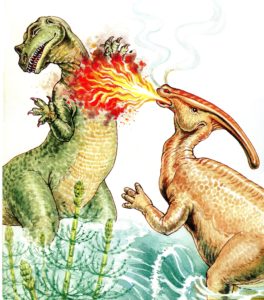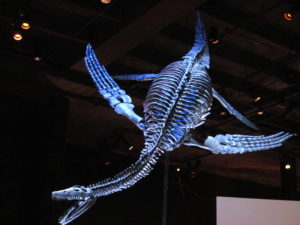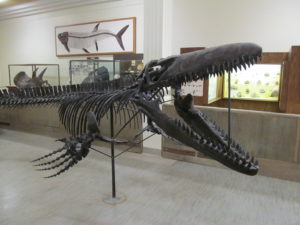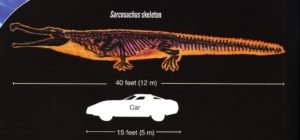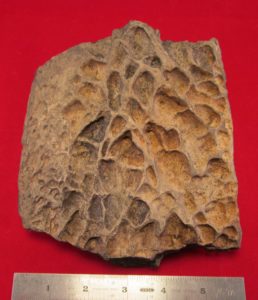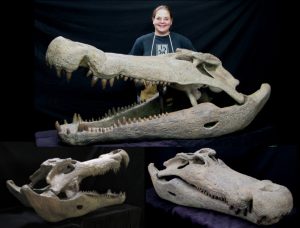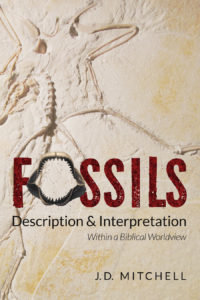In 2014 I did research on the book of Job in the Bible that resulted in my PowerPoint presentation, “In Search of Leviathan.” This article will review that research and also consider a new creationist proposal that the dinosaur Spinosaurus was the creature called Leviathan that God describes in Job chapter 41.
In my slide presentation I consider if Leviathan is mythical, real, extant, or extinct. I quickly came to the conclusion that it was real for three strong reasons:
A. The book of Job consists of loads of scientific facts about creation. God is not answering Job’s questions at all, but rather is exalting the creation and lauding His total sovereignty over all His creation, including the magnificent beasts Behemoth and Leviathan.
B. God begins speaking to Job in chapter 38. In chapters 38 and 39 God mentions over a dozen real animals, most of which are extant. Mythical animals are not mentioned.
C. God could not make His point to Job if He began speaking of mythical animals in chapters 40 and 41 that were outside of the creation.
There are 34 verses and over 500 words of description by God in Job 41. Since I do not read Hebrew, I used four different translations into English for understanding these descriptions of Leviathan. I used the King James Version, The New International Version, The Revised Standard Version, and the English Standard Version. Following are my 14 conclusions concerning Leviathan from the biblical text in chapter 41.
- Leviathan prefers the water but can also survive on land: (Verses 1, 25, 30, 31, 32).
- Leviathan has a large tongue: (Verse 1).
- Leviathan is too ferocious for men to get near and cannot be controlled by men: (Verses 2, 3, 4, 5, 6, 7, 8, 9, 10, 13, 14, 22, 25, 33).
- Leviathan has a 2-nostril nose and jaws: (Verses 2, 20).
- Leviathan has a tough hide and a skull that is resistant to harpoons, darts, javelins, arrows, clubs and spears: (Verses 7, 13, 26, 27, 28, 29).
- Leviathan has unusually strong scales that are close-knit: (Verses 15, 16, 17, 23).
- Leviathan has a very hard chest and has a jagged underside that leaves distinctive marks as he moves through mud: (Verses 24, 30).
- Leviathan has at least two limbs: (Verse 12).
- Leviathan is absolutely strong as well as graceful: (Verses 12, 22).
- Leviathan has a large mouth filled with fearsome teeth: (Verse 14).
- Leviathan’s snorting throws out flashes of light, sparks of fire, and smoke: (Verses 18, 20).
- Leviathan’s mouth shoots out fire: (Verses 19, 21).
- Leviathan can “rise-up” and when he does men are terrified: (Verse 25).
- Leviathan can only be controlled by his Creator, and Leviathan was created to remind men of God’s sovereignty and to humble them before His creation: (Verses 10, 11, 12, 34).
The next question is: What kind of animal was Leviathan? Types of animals I have found that have been considered by various creationist researchers are:
a. A land animal like a dinosaur.
b. A whale.
c. A sea monster.
d. A marine reptile.
e. A sea dragon.
f. A giant sea turtle.
g. A crocodile.
For my slide presentation I rejected land animals like Tyrannosaurus and Parasaurolophus because they would not have been able to live in the water. They clearly had a land habitat only. But, I will consider again the option of a dinosaur when Spinosaurus is looked at later in this article.
Figure 1: Tyrannosaurus & Parasaurolophus
After considerable investigation I found that sea monsters, marine reptiles, sea dragons, and sea serpents are all descriptive titles for the same kinds of animals. None of them had or have the ability to survive on land, so they are rejected as being Leviathan on that point alone.
Figure 2: Plesiosaurus Skeletal Reconstruction
Figure 3: Mosasaurus Skeletal Reconstruction
Whales do not qualify for the same reason that they could not live on land either. Giant turtles from the rock record don’t have teeth so they are out. But, I did discover an animal fossilized in the rock record that matched up to God’s descriptions the best of all. That is the Sarcosuchus giant crocodile. Here are some Sarcosuchus facts:
- Length: Up to forty feet.
- Weight: Estimated up to 10 tons (20,000 pounds).
- Locations of fossils: Sahara Desert of Africa and Bahia Basin of Brazil.
- Jaw length: Six feet.
- Teeth: 100 up to six inches long.
- Bony armor-plate scutes: Head-to-toe up to 12 inches long.
- Snout: Round, bowl-shaped protrusion.
Figure 4: Sarcosuchus Monster Crocodile Reconstruction
Figure 5: Sarcosuchus skeleton compared to a car (from Dragons of the Deep)
Sarcosuchus was huge and fierce, could have lived on land and in the water, had terrible large teeth, could have had a smoke and fire chamber in its bulbous nose, and would have left distinctive marks as it moved through mud. But, the most telling characteristic is the huge, thick scutes that covered its body. These scutes are not found on the other candidates for Leviathan that creationists have promoted. That would make Sarcosuchus the best contender to meet the requirements for a “tough hide and a skull that is resistant to harpoons, darts, javelins, arrows, clubs, and spears, and a hard chest and jagged underside.” These scutes have been found in the fossil record up to 12 inches long and over one inch thick!
Figure 6: Sarcosuchus 6”square X 1.25” thick fossil scute replica
We know that Sarcosuchus lived at the time of the global Flood because that is how it became a fossil. And if it was the animal God called Leviathan, we can know it lived at the time of Job just a few hundred years after the Flood. Does Sarcosuchus live today? Large salt water crocodiles still exist today, but none have been discovered that approach the extreme descriptions of Sarcosuchus.
However, there are many land areas of the earth that are unexplored and the ocean depths are very poorly explored. There may be many creatures including Behemoths and Leviathans of the Bible still yet to be (re)discovered, not seen for centuries. People must resist secular thought that is based on the atheistic presuppositions of naturalism and deep time. Job lived only about 4,000 years ago so these creatures lived not that long ago also. We cannot know for sure that Leviathan is extinct.
With regard to the description of Leviathan’s smoke and fire we must remember that fire flies produce light, eels produce electricity, and bombardier beetles produce explosive chemical reactions. With that in mind, it is not farfetched for us to believe that Leviathan could have breathed out some combination of gaseous fumes which could have ignited when they came into contact with oxygen.
I am not alone with the opinion that Sarcosuchus is Leviathan. In 2005 Dr. Carl Wieland published the book, Dragons of the Deep [Master Books, p.44-47] where he indicated that he thought Sarcosuchus represented the best suspect for Leviathan for basically the same reasons that I have presented.
Added to this article May 2024: (Another large extinct fossil crocodile that is a possible candidate for Leviathan is Deinosuchus.)
Deinosuchus Replica Skull
SPINOSAURUS AS LEVIATHAN
How about the dinosaur Spinosaurus? In Dr. Tim Clarey’s latest dinosaur book [Dinosaurs—Marvels of God’s Design, 2015, Institute for Creation Research, p. 71.] he proposes that a dinosaur like Spinosaurus may be the Leviathan that God describes in Job 41.
Figure 7: Spinosaurus skeletal reconstruction in swimming position (Wikipedia)
The fossil remains of Spinosaurus are very incomplete. The paleontologists who have written about these remains do not agree on much. A majority do write that they think this large dinosaur, whose remains were first found in North Africa, was likely semiaquatic (i.e. lived on both land and water) as are modern crocodiles. Its skull was long, low, and narrow, and that too reminds one of crocodiles. The distinctive characteristic of Spinosaurus is its tall (up to six feet high) neural spines that grew out of its backbone. The purpose of this large “sail” is unknown, but several paleontologists hypothesize it assisted with underwater maneuverings.
Many Spinosaurus teeth are regularly found in the sediments of Morocco, but there is so far no indication of scutes in the fossil record for this dinosaur. This means that Spinosaurus does not meet the description of having “a tough hide resistant to harpoons, darts, javelins, arrows, clubs, and spears.” Nor does it match to the description of having “unusually strong scales that are close-knit.” From my experience most animals from the fossil record that had scutes left a lot of scutes due to that fact that the scutes are made of a hard material that is relatively easy to fossilize.
CONCLUSIONS:
Spinosaurus does not meet the descriptions of Job 41 to the extent that Sarcosuchus does. Therefore, I will stick to my previous conclusion that Sarcosuchus, or some other giant crocodile, are the best candidates for Leviathan.
I think what God wants us all to remember today is that Leviathan could only be controlled by his Creator, and Leviathan was created to remind men of God’s sovereignty and to humble them before His creation.
J.D. Mitchell
For more information on fossils get my book:
